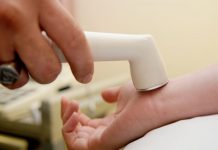Trans-oral Robotic Surgery -TORS is done with the help of a surgical robot. This type of surgery aims at the removal of a tumour within mouth or throat. TORS gives the surgeon an enhanced view of cancer and its surrounding tissue. The doctors’ use a robotic system to guide the surgery and the surgical tools allows for more precise movements in restricted spaces and can work perfectly around corners. When compared with more traditional procedures, trans-oral robotic surgery is just perfect for oral cancer and has been seen to deliver quicker recovery and fewer complications.
This surgery can be done to treat following types of cancers:
- Mouth Cancer
- Tongue Cancer
- Throat Cancer
- Tonsil Cancer
How is TORS done –
In this surgery, the surgeon sits at a remote control console which is kept at a short distance from the patient and the operating table. The surgeon controls the motion of the surgical instruments using two hand and finger control devices. The screen displays a bigger, magnified, and 3-D view of the surgical area that enables the surgeon to see and supervise the procedure at its best and with greater detail as compared to traditional laparoscopic surgery.
The patient is given general anaesthesia and he does not even experience a prick post that. After that, the surgeon puts the respective instruments and retractors within the patient’s mouth, thereby exposing the area that is targeted for operation. This is one of the most vital parts of the surgery, because once the robot gets the correct area, it becomes very easy to perform the surgery. After this step, the robot comes into play. It has a 3D camera and two arms for surgical purpose. One of the arms has the device to grasp and the other has the device to cut. Camera and both arms are inserted in your mouth to perform the surgery.
The surgeon sitting away from you operates inside your mouth with the help of the robot. The cutting arm is used to chop off the tumour and with the grasping arm, the device pulls it out.
Risks with TORS –
Just like any other procedure, there are certain risks that you should be aware of. It actually depends on the extent and type of surgery you undergo:
- Bleeding
- Infection
- Difficulty in speaking or Dysarthria
- Difficulty in swallowing or Dysphagia
- Saliva fistula (leakage of saliva from mouth to neck)
In comparison to other surgical operations, trans-oral robotic surgery offers excellent cure rates with fewer complications and shorter hospital stays. This is considered as one of the best methods of removing the tumours near the mouth region.









